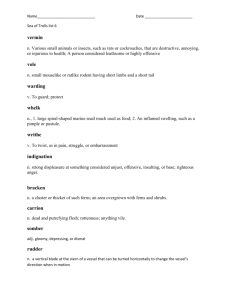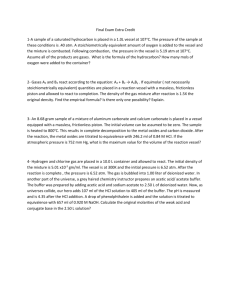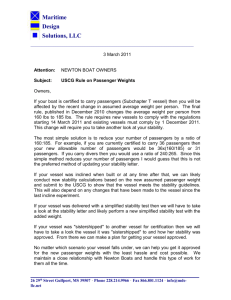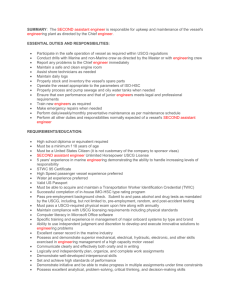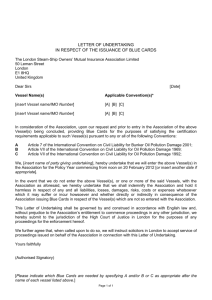Maritime Training Package
advertisement
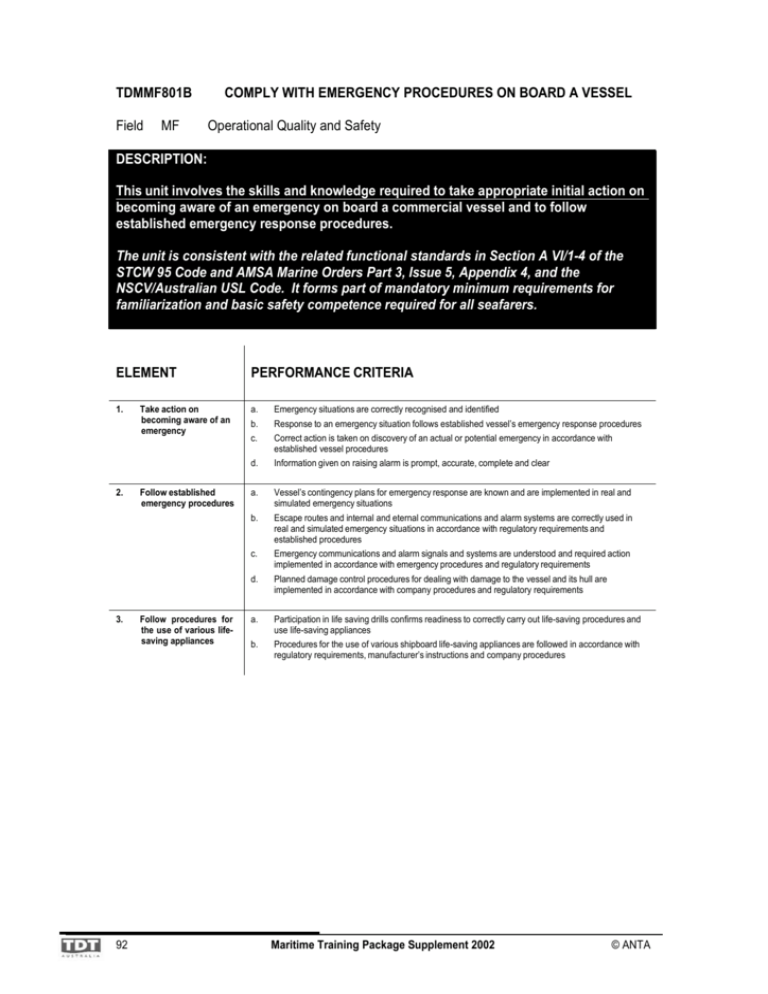
TDMMF801B Field MF COMPLY WITH EMERGENCY PROCEDURES ON BOARD A VESSEL Operational Quality and Safety DESCRIPTION: This unit involves the skills and knowledge required to take appropriate initial action on becoming aware of an emergency on board a commercial vessel and to follow established emergency response procedures. The unit is consistent with the related functional standards in Section A VI/1-4 of the STCW 95 Code and AMSA Marine Orders Part 3, Issue 5, Appendix 4, and the NSCV/Australian USL Code. It forms part of mandatory minimum requirements for familiarization and basic safety competence required for all seafarers. ELEMENT PERFORMANCE CRITERIA 1. a. Emergency situations are correctly recognised and identified b. c. Response to an emergency situation follows established vessel’s emergency response procedures Correct action is taken on discovery of an actual or potential emergency in accordance with established vessel procedures d. Information given on raising alarm is prompt, accurate, complete and clear a. Vessel’s contingency plans for emergency response are known and are implemented in real and simulated emergency situations b. Escape routes and internal and eternal communications and alarm systems are correctly used in real and simulated emergency situations in accordance with regulatory requirements and established procedures c. Emergency communications and alarm signals and systems are understood and required action implemented in accordance with emergency procedures and regulatory requirements d. Planned damage control procedures for dealing with damage to the vessel and its hull are implemented in accordance with company procedures and regulatory requirements a. Participation in life saving drills confirms readiness to correctly carry out life-saving procedures and use life-saving appliances b. Procedures for the use of various shipboard life-saving appliances are followed in accordance with regulatory requirements, manufacturer’s instructions and company procedures 2. 3. 92 Take action on becoming aware of an emergency Follow established emergency procedures Follow procedures for the use of various lifesaving appliances Maritime Training Package Supplement 2002 © ANTA Range Of Variables COMPLY WITH EMERGENCY PROCEDURES ON BOARD A VESSEL VARIABLE SCOPE 1. a. Work must be carried out in compliance with the relevant maritime regulations b. Responses to emergency situations follow a prescribed range of emergency procedures either individually or in a team environment with some accountability for the quality of outcomes c. Responses involve the use of known and defined emergency systems and procedures across a variety of emergency contexts a. Vessel may include any Australian or international commercial vessel b. Potential emergencies may occur: b.1. by day or night b.2. under any possible conditions of weather and loading b.3. while underway b.4. during berthing and unberthing operations b.5. while anchoring or mooring b.6. when bunkering b.7. during cargo handling operations c. Emergencies may include: c.1. collision with another vessel c.2. explosion on board vessel c.3. fire on board vessel c.4. impairment of integrity of hull and ingress of water c.5. loss of steering control c.6. loss of motive power c.7. foundering c.8. grounding c.9. beaching a vessel c.10. person overboard c.11. rescue and evacuation of injured personnel c.12. cyclones or severe weather d. Damage control measures in a flooding emergency may include: d.1. use of softwood wedges and plugs to reduce water ingress d.2. erection and application of vertical shoring d.3. construction and fitting of a leak-stopping mat d.4. temporary repair of a ruptured pressurised pipe d.5. operation of a portable salvage pump e. Damage control measures in a fire or explosion emergency may include: e.1. use of appropriate fire fighting equipment and techniques such as various types of fire extinguishers, fire blankets, fire hoses and nozzles, and foam applicators e.2. activation of fixed fire fighting sprinklers and systems e.3. removal of fuel or heat source e.4. boundary cooling techniques f. Survival equipment may include: f.1. life jackets f.2. exposure and immersion suits f.3. survival craft 2. General context Worksite environment 3. Sources of information/ documents a. Sources of information and documentation may include: a.1. relevant maritime regulations a.2. SOLAS Convention a.3. vessel’s emergency response procedures a.4. emergency procedures a.5. vessel manufacturer’s instructions and recommended procedures for damage control measures a.6. instructions of relevant Maritime Authorities 4. Applicable International, Australian and State/Territory regulations and legislation a. Applicable regulations and legislation may include: a.1. IMO STCW 95 Code and Convention a.2. relevant sections of the NSCV/Australian USL Code a.3. relevant sections of AMSA Marine Orders a.4. relevant international, Australian and State/Territory Marine & OH&S legislation © ANTA Maritime Training Package Supplement 2002 93 Evidence Guide COMPLY WITH EMERGENCY PROCEDURES ON BOARD A VESSEL 1. Critical aspects of evidence to be considered a. Assessment must confirm appropriate knowledge and skills to: a.1. Take appropriate action in the event of discovering a shipboard emergency a.2. Follow vessel’s contingency plans for emergency response a.3. Follow procedures for the use of various life-saving appliances a.4. Implement damage control following a shipboard emergency in accordance with instructions a.5. Identify typical problems that may occur during a shipboard emergency and take appropriate action a.6. Communicate effectively with others during shipboard emergencies a.7. Participate in drills to prepare shipboard personnel to implement emergency response 2. Interdependent assessment of units a. This unit of competency may be assessed in conjunction with other units that form part of a job role of any seafarer. (It is a mandatory requirement for all seagoing personnel) 3. Required knowledge and skills a. Knowledge of relevant maritime regulations b. Relevant OH&S legislation and policies c. Navigational emergencies for vessels and appropriate action and solutions d. Indications of various types of emergency situations and the action to be followed when various types of actual or potential emergency situations are identified e. Emergency alarm signals and systems in use on vessels and procedures to be followed when an emergency alarm is raised f. g. Escape routes and internal and external communications systems and alarms on board a vessel General principles of damage control and the manner in which watertight integrity of hull is maintained on a vessel, including the importance of preparation, control and repair h. Ways of controlling damage during a flooding emergency, including the use of various shipboard items that can be used for damage control purposes such as mattresses, canvas and clothing i. Maritime communication techniques used during navigational emergencies a. Access is required to opportunities to either: 4. 5. 94 Resource implications Consistency in performance a.1. participate in a range of role plays, case studies and/or other simulated practical and knowledge assessments that demonstrate the skills and knowledge to respond to emergency situations onboard a commercial vessel, and/or a.2. follow emergency response plans and procedures during real and simulated emergency situations on board an operational commercial vessel a. Applies underpinning knowledge and skills when: a.1 taking initial action during real and simulated emergency situation a.2 implementing emergency during a real and simulated emergency situations a.3 identifying and evaluating problems that may occur during a shipboard emergency and determining appropriate courses of action a.4 applying safety and life-saving precautions and procedures during emergency situations on board vessel a.5 participating in drills aimed at preparing shipboard personnel to implement emergency response plans b. Shows evidence of application of relevant workplace procedures including: b.1 relevant maritime regulations b.2 OH&S regulations and hazard prevention policies and procedures b.3 relevant procedures and regulations relating to shipboard emergencies and damage control b.4 shipboard safety procedures b.5 environmental protection during emergencies c. Action taken promptly to report and/or rectify shipboard emergencies in accordance with established procedures d. Work is completed systematically with required attention to detail Maritime Training Package Supplement 2002 © ANTA Evidence Guide (continued) COMPLY WITH EMERGENCY PROCEDURES ON BOARD A VESSEL 6. Context for assessment a. Assessment of competence must comply with the assessment requirements of the relevant maritime regulations b. Assessment of this unit must be undertaken within relevant marine authority approved and audited arrangements by a registered training organisation: b.1. As a minimum, assessment of knowledge must be conducted through appropriate written/oral examinations b.2. Appropriate practical assessment must occur: b.2.1. at the registered training organisation, and/or b.2.2. on an appropriate working or training vessel KEY COMPETENCIES Collect, Analyse & Organise Information Communicate Ideas & Information Plan & Organise Activities Work with Others & in Teams Use Mathematical Ideas & Techniques Solve Problems Use Technology 2 2 1 2 1 1 1



